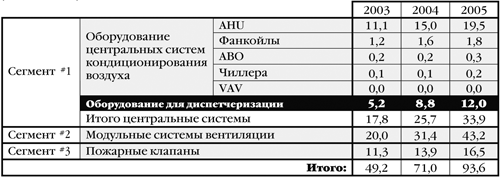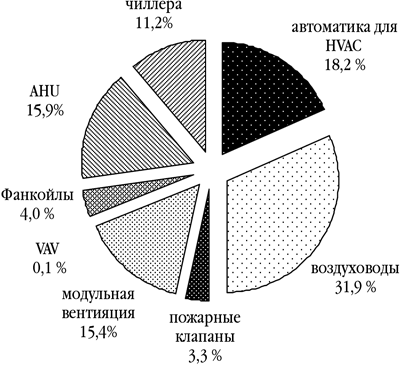Russian market of automation for HVAC.
The Russian market of automation for ventilation and air conditioning was formed in the mid-90s, with the first mass deliveries of imported equipment for central air conditioning and ventilation systems that needed automation systems.
It is not surprising that the same segments were formed on the automation market as on the ventilation equipment market. At the same time, different suppliers and manufacturers took the lead in each of them.
Knowing the place of each segment in the overall sales volume is the key to understanding the structure and dynamics of the Russian BAS market.
The Russian HVAC equipment market in 2005 (in prices for the end consumer excluding the cost of automation).
The first segment is automation for central air conditioning systems, mainly equipment for automating the operation of AHU (chillers are supplied fully equipped). Until 1999, this segment was almost entirely occupied by Honeywell products.
In the second segment– automation for modular ventilation systems – initially dominated by products of the company Regin, supplied including under OEM brands.
In the third segment– automation for fire ventilation systems (drives for fire-retardant valves and smoke exhaust valves) – up until 2004 there were only two manufacturers: VINGS-M and Fire, both of which used Belimo drives. This situation is due to the impossibility of certifying both new imported and new domestic valves in the fire department.
Today this division is less clearly expressed. A number of manufacturers and sellers successfully operate in all three market segments, although certain preferences have been preserved.
The automation currently in use can be divided into two levels. The first is the automation that is minimally required for the operation of HVAC equipment. In the table, it is highlighted in gray. The second level is automation for switching on HVAC systems in the building's BAS (highlighted in black). In 99% of cases, this automation is used with central air conditioning systems, while modular ventilation systems and fire valves are practically not dispatched.
The study showed that the main automation manufacturers are active in this market segment, and therefore, when assessing the Russian HVAC automation market, they usually focus on it.

The structure of the HVAC automation market by climate market segments in dealer prices, in million euros. Only the cost of equipment is taken into account
The table shows that the share of automation installed in central air conditioning systems consistently accounts for 36% of the total capacity of the HVAC automation market, and within the segment, the share of automation used to switch HVAC equipment into BAS is growing. At the same time, AHU equipment is still mainly offered for the automation of central air conditioning systems. An automation kit for AHU usually costs 1.5-3.5 thousand euros, depending on the «stuffing» and the performance of the unit.
The segment of automation for fire valves occupies a significant part of the market, but its share is decreasing. From 2003 to 2005, it decreased from 23% to 18%. Automation in this market segment is represented by more than three quarters of electromechanical drives of fire valves.
And finally, the largest and fastest growing market segment: automation for modular ventilation systems. Its dynamics are associated with the outstripping growth of the modular ventilation systems market. If it is necessary to provide an inflow of up to 5 thousand cubic meters per hour, such equipment is much cheaper than AHU.
From 2003 to 2005, the share of automation for modular ventilation systems in the total volume of sales of automation for HVAC increased from 41% to 46%. This state of affairs, typical for Scandinavia, but extremely atypical for Europe as a whole, determines a number of key features of the Russian market.
Firstly, automation for modular ventilation systems is simpler and cheaper than for AHU. (On average, a set of automation for one supply system of this class costs about 800 euros).
Secondly, the dominance of automation for modular ventilation systems results in a very specific ratio of controllers and sensors. There are only two sensors per controller (including heating and fan speed regulators).
Thirdly, with such a market structure, the shares of various manufacturers present a very unusual picture. The reason is obvious: distributors selling modular ventilation systems are also the main suppliers of automation for this equipment. Therefore, they often use automation produced by ventilation equipment manufacturers (primarily speed controllers) and OEM products offered by them.
Based on the research materials
“Russian market of automation for HVAC”
